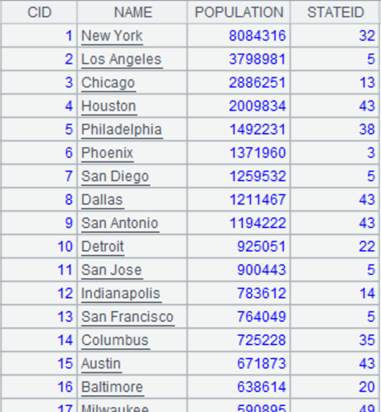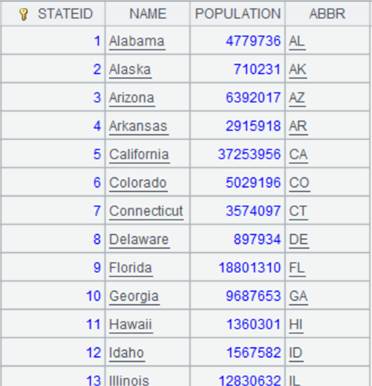CS.merge()
Description:
Merge data of the member cursors of a sequence of cursors and return a multicursor.
Syntax:
CS.merge(xi,…)
Note:
CS is a sequence of cursors ordered by [xi,…], and from each cursor a sequence of records can be output. The function merges the records of these cursors by the expression xi and returns a multicursor.
Members of the cursor sequence must be of the same structure. If members are multicursors, they must have the same number of parallel cursors and be segmented synchronically.
This is a delayed function.
Parameter:
|
CS |
A sequence of cursors. |
|
xi |
An expression. If performing merge by multiple fields, use comma to separate them, for example, x1,x2... |
Option:
|
@u |
Union operation. Remove the duplicate records from the resulting cursor obtained by unioning the cursor members of CS in certain order. By default, the duplicate records are included. |
|
@i |
Intersection operation. Return a cursor composed of common members of members of CS, the sequence of cursors. |
|
@d |
Difference operation. Create a new cursor by removing members of CS2&…CSn from CS1. |
|
@0 |
Put records with null values at the end. |
|
@x |
Only merge distinct records in member cursors. |
Return value:
Multicursor
Example:
|
|
A |
|
|
1 |
=connect("demo").cursor("SELECT top 10 EID,NAME,DEPT,GENDER FROM employee ") |
Return a cursor whose data is as follows:
|
|
2 |
=connect("demo").cursor("SELECT top 5 EID,NAME,DEPT,GENDER FROM employee where GENDER='M' ") |
Return a cursor whose data is as follows:
|
|
3 |
=connect("demo").cursor("SELECT top 5 EID,NAME,DEPT,GENDER FROM employee where DEPT='Sales' ") |
Return a cursor whose data is as follows:
|
|
4 |
=[A1,A2,A3] |
Return a sequence of cursors. |
|
5 |
=A4.merge(EID) |
Merge records in the cursor members of the sequence in order according to EID field. |
|
6 |
=A5.fetch() |
Fetch data from cursor A5 (it would be better to fetch data in batches when a huge amount of data is involved):
|
Use @u option to perform union operation:
|
|
A |
|
|
1 |
=connect("demo").cursor("SELECT top 10 EID,NAME,DEPT,GENDER FROM employee ") |
Return a cursor whose data is as follows:
|
|
2 |
=connect("demo").cursor("SELECT top 5 EID,NAME,DEPT,GENDER FROM employee where GENDER='M' ") |
Return a cursor whose data is as follows:
|
|
3 |
=connect("demo").cursor("SELECT top 5 EID,NAME,DEPT,GENDER FROM employee where DEPT='Sales' ") |
Return a cursor whose data is as follows:
|
|
4 |
=[A1,A2,A3] |
Return a sequence of cursors. |
|
5 |
=A4.merge@u(EID) |
Use @u option to merge records of member cursors in the sequence in order according to EID field, during which dulicate members are discarded. |
|
6 |
=A5.fetch() |
Fetch data from cursor A5:
|
Use @i option to perform intersection operation:
|
|
A |
|
|
1 |
=connect("demo").cursor("SELECT top 10 EID,NAME,DEPT,GENDER FROM employee ") |
Return a cursor whose data is as follows:
|
|
2 |
=connect("demo").cursor("SELECT top 5 EID,NAME,DEPT,GENDER FROM employee where GENDER='M' ") |
Return a cursor whose data is as follows:
|
|
3 |
=connect("demo").cursor("SELECT top 5 EID,NAME,DEPT,GENDER FROM employee where DEPT='Sales' ") |
Return a cursor whose data is as follows:
|
|
4 |
=[A1,A2,A3] |
Return a sequence of cursors. |
|
5 |
=A4.merge@i(EID) |
Use @i option to get the intersection and returna cursor containing common records of the member cursors in the sequence. |
|
6 |
=A5.fetch() |
Fetch data from cursor A5:
|
Use @d option to perform difference operation:
|
|
A |
|
|
1 |
=connect("demo").cursor("SELECT top 10 EID,NAME,DEPT,GENDER FROM employee ") |
Return a cursor whose data is as follows:
|
|
2 |
=connect("demo").cursor("SELECT top 5 EID,NAME,DEPT,GENDER FROM employee where GENDER='M' ") |
Return a cursor whose data is as follows:
|
|
3 |
=connect("demo").cursor("SELECT top 5 EID,NAME,DEPT,GENDER FROM employee where DEPT='Sales' ") |
Return a cursor whose data is as follows:
|
|
4 |
=[A1,A2,A3] |
Return a sequence of cursors. |
|
5 |
=A4.merge@d(EID) |
Use @d option to perform the difference operation that removes records of cursor A2 and cursor A3 from cursor A1 and forms a new cursor. |
|
6 |
=A5.fetch() |
Fetch data from cursor A5:
|
Use @x option to get non-duplicate members from the sequence of cursors to form a new sequence:
|
|
A |
|
|
1 |
=connect("demo").cursor("SELECT top 10 EID,NAME,DEPT,GENDER FROM employee ") |
Return a cursor whose data is as follows:
|
|
2 |
=connect("demo").cursor("SELECT top 5 EID,NAME,DEPT,GENDER FROM employee where GENDER='M' ") |
Return a cursor whose data is as follows:
|
|
3 |
=connect("demo").cursor("SELECT top 5 EID,NAME,DEPT,GENDER FROM employee where DEPT='Sales' ") |
Return a cursor whose data is as follows:
|
|
4 |
=[A1,A2,A3] |
Return a sequence of cursors. |
|
5 |
=A4.merge@x(EID) |
Use @x option to perform the difference operation that gets non-duplicate records from members cursors of the sequence to form a new sequence. |
|
6 |
=A5.fetch() |
Fetch data from cursor A5:
|
Related function:













